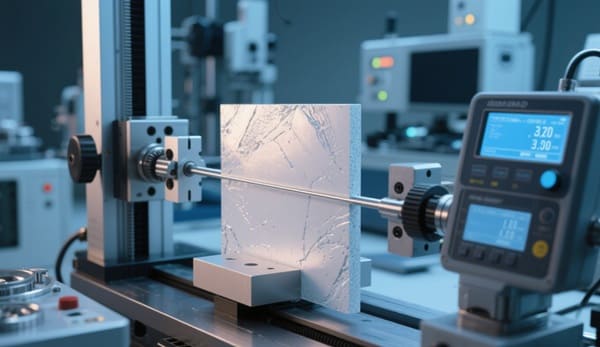What Role Does Alumina Tensile Strength Play in Material Science?
Alumina, or aluminum oxide (Al2O3), is one of the most widely used ceramic materials in material science due to its excellent combination of mechanical, thermal, and chemical properties. Among these properties, tensile strength is especially important as it determines how alumina behaves under pulling or stretching forces. Understanding alumina tensile strength helps engineers and scientists design components that can reliably withstand mechanical stresses, particularly in industries like magnetic materials manufacturing, electronics, and aerospace. This article delves into what alumina tensile strength is, how it’s measured, what factors affect it, and why it matters in practical applications.
At Advanced Ceramic Hub, we specialize in high-quality alumina products, ensuring optimal performance for industrial and scientific applications.

What is Alumina Tensile Strength?
Tensile strength is defined as the maximum stress a material can withstand while being stretched or pulled before breaking. For alumina, this property reflects its ability to resist fracture when subjected to tension, which is crucial for components exposed to mechanical loads. Unlike metals, alumina is brittle, and its tensile strength is generally lower compared to its compressive strength, but it remains a critical factor in predicting failure and ensuring safety.
| Property | Typical Range | Unit |
| Tensile Strength | 200 – 400 | MPa |
| Density | 3.9 – 4.1 | g/cm³ |
| Young’s Modulus | 300 – 400 | GPa |
This range indicates that alumina can tolerate moderate tensile stresses before failure, making it suitable for many structural applications where tensile loads are moderate.
How is Alumina Tensile Strength Measured?
Measuring tensile strength in brittle ceramics like alumina requires specific test methods because direct tensile tests are difficult due to specimen handling challenges. The most common methods include the Brazilian test, flexural (bending) tests, and direct tensile tests where possible. Each method aims to simulate tensile stress and evaluate how alumina behaves under tension.
| Test Method | Description | Advantages |
| Brazilian Test | Indirect tensile test applying compression across a disk | Simple and widely used |
| Flexural Test | 3-point or 4-point bending to induce tensile stress | Provides flexural strength data |
| Direct Tensile Test | Pulling specimens until failure | Most accurate tensile measurement, but difficult to perform |
Accurate testing ensures alumina components meet design requirements, preventing premature failure in critical applications.
What Factors Influence Alumina Tensile Strength?
Alumina’s tensile strength can vary widely depending on microstructural and processing factors. Grain size, porosity, impurities, and manufacturing techniques play key roles in determining its final mechanical performance.
| Defects such as cracks lower the strength | Effect on Tensile Strength | Control Measures |
| Grain Size | Smaller grains generally improve strength | Use fine powders and controlled sintering |
| Porosity | Higher porosity reduces tensile strength | Densification during sintering |
| Impurities | Impurities cause stress concentrations | Use high-purity raw materials |
| Manufacturing | Defects such as cracks lower strength | Quality control and optimized processes |
Optimizing these factors is crucial to producing alumina with consistent and high tensile strength, especially for demanding industrial uses.
Why is Alumina Tensile Strength Important in Magnetic Material Manufacturing?
Magnetic materials often incorporate ceramic parts that require mechanical robustness during fabrication and operation. Alumina’s tensile strength helps maintain structural integrity in insulation layers, supports, and protective coatings, which face mechanical stresses like thermal expansion and vibration.
| Application Area | Role of Alumina Tensile Strength | Benefits of Magnetic Materials |
| Magnet Insulation | Prevents cracking under thermal/mechanical stress | Ensures electrical insulation reliability |
| Structural Supports | Resists mechanical loads during use | Maintains dimensional stability |
| Protective Coatings | Shields components from wear and damage | Extends service life |
Using alumina with sufficient tensile strength ensures magnetic assemblies remain stable, safe, and effective throughout their lifespan.
How Does Alumina Tensile Strength Compare to Other Ceramic Materials?
Alumina offers a balanced combination of tensile strength, hardness, and chemical stability compared to other common ceramics like zirconia and silicon nitride. While its tensile strength is moderate, alumina excels in wear resistance and cost-effectiveness.
| Material | Tensile Strength (MPa) | Hardness (GPa) | Thermal Stability |
| Alumina | 200 – 400 | 15 – 19 | High |
| Zirconia | 300 – 700 | 12 – 14 | Moderate |
| Silicon Nitride | 500 – 1000 | 14 – 16 | Very High |
This balance makes alumina a popular choice for applications where moderate tensile loads combine with demanding chemical and thermal environments.
Explore our high-quality alumina ceramic product.
What Are the Common Applications of Alumina Tensile Strength?
Due to its mechanical properties, alumina with high tensile strength is used across many fields. It’s valued for electrical insulation, cutting tools, wear-resistant parts, and structural components in magnetic materials.
| Application | Description | Key Properties Needed |
| Electrical Insulators | Components that must resist mechanical and thermal stress while insulating electrically | High tensile strength, electrical insulation |
| Cutting Tools | Tools that require hardness and resistance to fracture | Hardness, toughness |
| Wear-Resistant Parts | Parts exposed to abrasion and mechanical wear | Hardness, tensile strength |
| Magnetic Components | Structural or insulating parts in magnets | Structural stability, durability |
These applications highlight the versatility of alumina ceramics with strong tensile properties.
How Can Alumina Tensile Strength Be Improved?
Improving alumina tensile strength focuses on controlling microstructure and defects. Techniques include doping with additives, optimizing sintering conditions, and minimizing internal flaws.
| Improvement Method | Mechanism | Effect on Tensile Strength |
| Element Doping | Introduces secondary phases to refine grain boundaries | Improves strength and toughness |
| Sintering Optimization | Controlled temperature and time enhance densification | Reduces porosity, increases strength |
| Defect Minimization | Limits cracks and voids during manufacture | Enhances reliability and strength |
Continuous advancements in processing technologies are expanding the tensile limits of alumina ceramics.
Request a custom quote for alumina ceramic products.
FAQ
This section answers common questions related to alumina tensile strength to clarify its role and limitations.
| Question | Short Answer |
| Can alumina tensile strength be measured directly? | Direct tests are challenging; indirect methods are more common but direct testing is possible with proper preparation. |
| What is the maximum tensile stress alumina can handle? | Typically ranges from 200 to 400 MP, depending on quality and processing. |
| How does temperature affect alumina tensile strength? | Tensile strength generally decreases at elevated temperatures due to material softening. |
These answers help engineers better understand alumina’s behavior in different scenarios.
Conclusion
Alumina tensile strength plays a pivotal role in determining the performance and reliability of alumina-based materials in material science. While alumina is brittle, its tensile strength can be optimized through precise control of microstructure and processing techniques. In magnetic material manufacturing and other demanding fields, maintaining sufficient tensile strength is essential to ensure long-lasting, durable components. Continued research and development in alumina processing will enhance its mechanical properties, expanding its applications even further.
Looking for high-quality alumina product? Contact us today!
